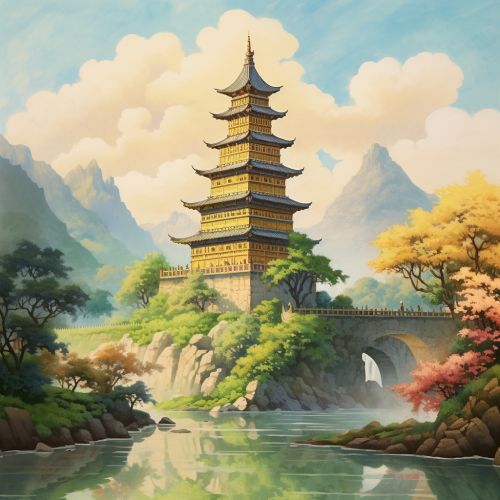Yellow Crane Tower
History
The Yellow Crane Tower, known as 'Huanghe Lou' in Chinese, is one of the Four Great Towers of China. It is located on Snake Hill in Wuhan, Hubei Province, overlooking the Yangtze River. The tower has a long and storied history, with its origins tracing back to the Three Kingdoms Period (220–280 AD).Learn more about the Three Kingdoms Period


The tower was initially built as a military watchtower by Sun Quan, the King of Eastern Wu. Over the centuries, it was destroyed and rebuilt several times, with the current structure being the seventh reconstruction, completed in 1985. The tower has served various purposes throughout its history, including being a gathering place for poets and artists, a symbol of regional pride, and a tourist attraction.
Architecture
The Yellow Crane Tower stands at a height of 51.4 meters and consists of five floors. Its architectural style is a representation of the pinnacle of ancient Chinese tower architecture, featuring upturned eaves, hanging corners, and intricate wood and stone carvings. The tower is painted yellow and glazed, giving it a majestic and solemn appearance that is a testament to the grandeur of traditional Chinese architecture.Learn more about Chinese architecture
The interior of the tower is equally impressive, with each floor featuring different themes and decorations. The first floor houses a large mural depicting the history of the tower, while the second floor contains a series of poems written by famous poets who visited the tower. The third floor is dedicated to the legend of the yellow crane, which is an integral part of the tower's history and cultural significance.
Cultural Significance
The Yellow Crane Tower is not only an architectural marvel but also a cultural icon. It has been the subject of numerous poems and songs throughout Chinese history, with the most famous being a poem by Cui Hao titled 'Yellow Crane Tower'. The poem, written during the Tang Dynasty, describes the tower's beauty and its view over the Yangtze River, cementing the tower's place in Chinese cultural heritage.Learn more about the Tang Dynasty
The tower is also associated with several legends and myths, the most famous of which involves a yellow crane. According to the legend, a tavern owner once showed kindness to a poor man who turned out to be an immortal in disguise. In gratitude, the immortal drew a yellow crane on the wall of the tavern, which would dance whenever it heard music. This brought fame and fortune to the tavern owner, and when he eventually retired, he built the Yellow Crane Tower in honor of the immortal and the crane.
Tourism
Today, the Yellow Crane Tower is a popular tourist attraction, attracting millions of visitors each year. The tower offers panoramic views of the Yangtze River and the city of Wuhan, making it a favorite spot for photography. The tower complex also includes several other attractions, such as a statue of the yellow crane, a bell tower, and a stele forest featuring inscriptions from different dynasties.
Visitors to the tower can learn about its history and cultural significance through various exhibits and displays. They can also participate in cultural activities such as calligraphy demonstrations and traditional music performances, providing a rich and immersive experience of Chinese culture and history.
